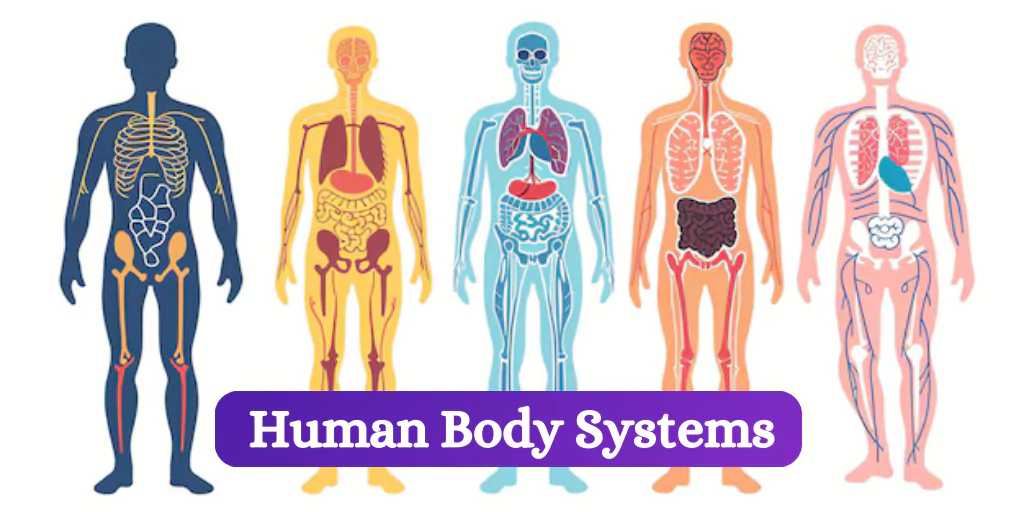Recently updated on May 1st, 2025 at 09:45 am
The human body is complex and harmonious to sustain life. Each system serves a distinct purpose, yet they are all interrelated to ensure the body runs smoothly. Understanding these systems allows us to comprehend how our bodies work and preserve overall health. Let’s look at the major systems of our body, including their functions and interconnections.
1. The circulatory system

The circulatory system, also called the cardiovascular system, includes the heart, blood arteries, and blood. Its main job is transporting oxygen, nutrition, hormones, and waste throughout the body. The heart circulates oxygen-rich blood to organs and tissues while transporting carbon dioxide and other wastes to the lungs and kidneys for removal.
Interconnection: The circulatory and respiratory systems work together to give oxygen to cells and eliminate carbon dioxide. It also works with the digestive system to absorb and distribute nutrients found in meals.
2. The Respiratory System

The respiratory system includes the lungs, trachea, bronchi, and diaphragm. It is in charge of gas exchange—bringing in oxygen and releasing carbon dioxide. When we breathe, oxygen enters the bloodstream and travels to the cells, while carbon dioxide is removed through exhalation.
Interconnection: The respiratory system works together with the circulatory system to guarantee that oxygen is delivered to all body cells. It also works with the neurological system to control breathing rates based on the body’s oxygen requirements.
3. The Digestive System

The digestive system consists of the mouth, oesophagus, stomach, intestines, liver, and pancreas. Its role is to digest food, absorb nutrients, and eliminate waste. Enzymes and digestive fluids help the body convert food into smaller molecules that it can use for energy and growth.
Interconnection: The digestive system communicates with the circulatory system to transfer ingested nutrients. It also works with the neurological system to control appetite, digestion, and metabolism.
4. The Nervous System

The nervous system includes the brain, spinal cord, and nerves. It regulates body functions, interprets sensory data, and directs movement. It facilitates communication between various regions of the body and aids in responding to stimuli.
Interconnection: The neurological system collaborates with the muscular system to promote movement. It also interacts with the endocrine system, regulating hormones that affect mood, growth, and metabolism.
5. The endocrine system

The endocrine system consists of hormone-producing glands such as the thyroid, adrenal glands, and pancreas. Hormones regulate a variety of bodily activities, including metabolism, growth, reproduction, and mood.
Interconnection: The endocrine system collaborates with the neurological system to maintain homeostasis. It also affects the reproductive system by controlling sexual development and fertility.
6. The Muscle System

The muscular system consists of skeletal, smooth, and cardiac muscles. It promotes movement, preserves posture, and creates heat. Voluntary muscles work with bones to assist movement, whereas involuntary muscles control internal organ activities.
Interconnection: The nervous system is responsible for controlling movement in the muscles. It also collaborates with the skeletal system to offer structural stability.
7. The Skeletal System

The skeletal system consists of bones, cartilage, ligaments, and joints. It provides structure, protects internal organs, and allows for mobility by acting as muscle attachment points.
Interconnection: The skeletal system collaborates with the muscular system and the circulatory system to produce blood cells in the bone marrow.
8. Our Immune System

The immune system is made up of white blood cells, the lymphatic system, and antibodies. It protects the body against infection, illness, and dangerous pathogens.
Interconnection: The immune system communicates with the circulatory system to transfer immune cells throughout the body. It also interacts with the digestive system, as gut bacteria influence immune function.
9. The Excretory System

The excretory system, which includes the kidneys, liver, bladder, and skin, eliminates waste and regulates fluid levels. It removes toxins from the bloodstream through urine, perspiration, and faeces.
Interconnection: The excretory system works with the circulatory system to filter waste from the blood, while the digestive system processes food waste.
10. The Reproductive System

The reproductive system consists of male and female reproductive organs that produce progeny. Males produce sperm, while females produce eggs, become pregnant, and give birth.
Interconnection: The reproductive system is governed by the endocrine system using hormones. It also works with the neurological system to regulate reproductive behaviour and activities.
Conclusion
The body is a complex yet beautifully coordinated mechanism, with each system contributing significantly to overall health and function. Their interrelated nature means that even minor disruptions can have far-reaching consequences, underlining the need for general well-being and a balanced lifestyle. Understanding these systems and how they interact allows us to properly care for our bodies and live healthier lives.






